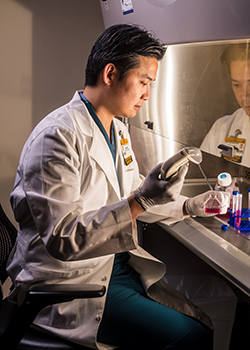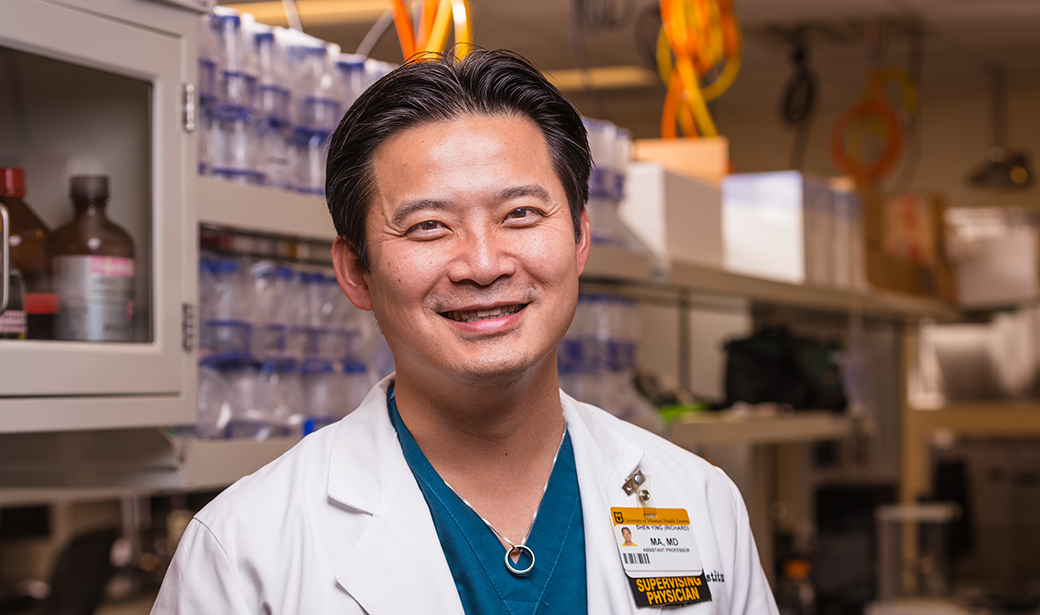When Richard Ma, MD, treats injured athletes who are desperate to return to their favorite sports, he can empathize. Athletics played an outsize role in his own identity. After he immigrated from Taiwan to the United States as a 7-year-old boy, Ma felt out of place. That changed when he joined his high school’s football and soccer teams.
“Sports are a big part of who I am,” he said. “My natural instinct, coming from another country and initially having a language barrier and not having a lot of friends, you tend to be a little more introverted. Athletics was a big part of building my confidence. I came out of my shell. I enjoyed the camaraderie of team sports.

“When I see injured athletes in clinic, my experience with athletics helps me understand why it’s so hard for them when they can’t play. I can identify with that. Although I have the privilege of taking care of Mizzou athletes, the vast majority of individuals I take care of are the athletes out in our community. That was me.”
Now a surgeon at MU Health Care’s Missouri Orthopaedic Institute, Ma’s focus in the clinic and laboratory is helping people return to their favorite activities as soon as possible after an injury — or, even better, preventing the injury. As an academic health system, MU Health Care employs physicians who actively conduct research that leads to innovation in patient care. In fact, the whole reason Ma joined MU Health Care five years ago was because patient care and research are so intertwined at MOI.
“When you get the scientists and the clinicians in the same building, we have a chance to have a conversation,” Ma said. “That’s pretty powerful but hard to do since research scientists and their laboratories are often in a separate location from clinicians. But at the Missouri Orthopaedic Institute, we are all working under the same roof.”
Ma specializes in arthroscopic repairs of shoulders and knees. Arthroscopy is a minimally invasive technique. Small incisions are made for a camera and surgical instruments. The camera allows the surgeon to see inside the joint on a monitor and make repairs without making big incisions and disrupting muscles, tendons and ligaments. The recovery period is typically far quicker than more invasive surgeries, although often not quick enough for eager athletes.
In the field of sports medicine, there is always a question of when an injury is truly healed. Ma often fixes torn anterior cruciate ligaments — one of the four stabilizing ligaments in the knee — and he wondered if secrets to a better ACL surgery could be found at the cellular level.
ACLs usually are repaired with tissue from a patient’s patellar tendon, quadriceps tendon or hamstring tendon, and occasionally with donor tissue. Ma is trying to determine if there is a best choice among those grafts based on the individual needs of a patient.
“Biologically, the cells of all those tissue types behave differently under different mechanical stresses and stimulus,” he said. “If you understand those differences, then maybe you would choose tissues that best match the person’s activity level, or you adapt their rehabilitation after surgery to the particular tissue that was used.”
Traditionally, doctors determine when ACL patients are ready to resume full activity based on the length of time since surgery and the stability and functionality of the knee. Those benchmarks alone might not give a full picture. To better understand when a repaired ACL is fully healed, Ma is conducting a clinical study of more than 30 patients who had the surgery in the last year.
“We all have a baseline chemical body composition,” he said. “If we have an injury or we have surgery, there is probably a disruption of that chemical balance. When do you reach that balance again? And does that balance reflect what’s going on in the knee in terms of healing from the surgery? In the study, we are collecting urine from patient volunteers and looking at the chemical composition to see if we can identify specific proteins and their levels that might correspond to how your knee is doing after surgery.
“We’ll follow these people to a year out and start analyzing samples and then bring some of these kids back and get MRIs of their knees. We’ll see if the MRI picture of the knee and ACL graft fits with specific patterns we see in the chemical profile of the urine we collected. If you have a simple noninvasive test you can do in the clinic that tells you how that person is doing biologically after knee reconstructive surgery, that might be an important piece of information that would cut down on the reinjury rate.”
One of Ma’s mentors is James Cook, DVM, PhD, OTSC, the director of MU’s Thompson Laboratory for Regenerative Orthopaedics. Cook is doing similar research on biomarkers related to osteoarthritis. He said Ma’s project could ultimately identify athletes prone to noncontact ACL tears before they are ever injured and determine methods for prevention.
“Most of the predictive work done on risk for ACL injuries is based on body mechanics,” Cook said. “It’s really important to look at the biomechanics, but we also have to look at the biology. Currently, there’s nothing that looks at the biology of risk for ACL. That’s what Dr. Ma’s innovative research potentially could do.”
It all goes back to his desire in the lab and clinic to find ways to help patients keep doing what they enjoy.
“What I love about him is that he’s a true clinician-scientist,” Cook said.
“Those two words have to go together to significantly advance health care in real time. To me, that’s the way it should be. His clinic feeds his science, because that’s where his ideas come from. His science feeds his clinic, because he wants to practice evidence-based medicine.
“His patients absolutely adore him. I think they understand that he’s trying to do patient-specific, evidence-based care to help them accomplish their goals. He’s trying to do the best thing for them based on real science.”



